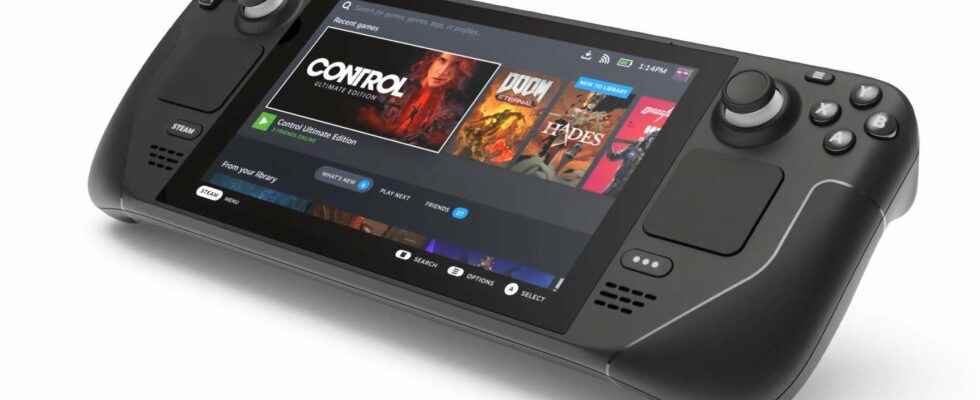The portable console market has shrunk considerably since the advent of tablets and smartphones. However, two manufacturers continue to fill this niche with their machines: Valve and Nintendo.
You will also be interested
[EN VIDÉO] Do video games have an impact on our behavior? We have long heard that violence in video games can negatively impact societal habits, but are we sure?
One key thing to note is that while the two machines look alike, they are quite different in essence. The Switch is a game console hybrid which has a portable mode and a dock to connect it to a television or a screen. the Steam Deckmeanwhile, is actually a laptop, with all the flexibility and particularities that this entails. Deciding whether you want a Steam Deck or a Switch is therefore more about assessing your own gaming habits than comparing the details of each device.
Technical specifications
The nintendo-switch is available in three models:
- a Switch Lite intended exclusively for portable use;
- the “classic” Switch marketed since 2017;
- the Switch OLED which differs from its big sister by a larger screen and an Oled panel instead of the LCD.
The Steam Deck, like the nintendo Switch, is offered in several versions. In its default configuration (64 GB eMMC storage), the Steam Deck costs €419 but can go up to €679 for the model equipped with a SSD 512 GB. It can be ordered now, but be prepared to wait several months before getting the Steam Deck due to shortages on electronics.
Right off the bat, it’s clear that Valve is courting a more discerning audience. At €419, the cheapest Steam Deck costs more than the most expensive variant of the nintendo-switch. At $679, the most expensive Steam Deck costs more than three times as much as the Switch Lite.
Design Steam Deck versus nintendo-switch
For one, the two machines look alike, as they’re both handheld consoles, optimized to run modern games. On the other hand, the Steam Deck is more suitable for video games on computerwhile the Switch offers a simplified experience to reach the general public.
The Steam Deck and the Switch are rectangular consoles with 7-inch and 6.2-inch touchscreens respectively. screen OLED of the Switch tops out at 720p while theLCD screen of the Steam Deck supports a resolution slightly higher 1280 x 800. Both have directional buttons and a stick analog on the left, as well as another analog stick and face buttons on the right.
What is different is that the Steam Deck also has a trackpad on each side, for games and apps PCs that require a mouse. The Steam Deck is also equipped with a built-in microphone, but curiously, there does not seem to be a camera. In-game chat should be easy, but video chat won’t be possible without connecting a webcam.
Power and autonomy
One area where the Steam Deck dominates: the hardware. The Switch was not console most powerful when it debuted in 2017, and the Switch Oled did not change the hardware much. Nintendo’s latest variant has a processor Nvidia Tegra X1, a GPUs Nvidia Maxwell and 4 GB of RAM, just like the base model. However, instead of the flash memory 32 GB eMMC from the base model, the Oled has 64 GB. You can also store games on a microSD card, but your data from backup remain attached to your console, unless you pay for Nintendo Switch Online and its cloud save features.
As we mentioned above, the Steam Deck offers varying storage options, depending on how much you’re willing to pay. But all models have the same processor and GPU: an AMD Zen 2 3.5 GHz and an AMD RDNA.2, respectively. The system has 16 GB of RAM and support Bluetooth 5.0 complete. While the Switch will employ middling Bluetooth capabilities that will limit controller use to two when a wireless audio device is connected. While it’s hard to compare specialty CPUs and GPUs for consoles, there’s no denying that the Steam Deck feels a lot more powerful. It should also be noted that theautonomy of the two consoles will vary greatly, depending on what you play. The Steam Deck promises 7-8 hours, while the Switch aims for 5-9 hours.
Games catalog
The Steam Deck has the potential to run hundreds, if not thousands, of more games than the Switch. That’s because at heart, the Steam Deck is just a small PC, and PCs have access to the biggest toy library in the world. You’ll be able to install just about anything on Steam, of course, but Valve also promises you’ll be able to install and use pc software as well as Windows. In theory this means that if you can find a way to download your software, you will be able to play it.
While the Steam Deck’s selection of potential games will be much larger, the Switch isn’t without charm. Nintendo still has a solid selection of exclusive titles, The Legend of Zelda: Breath of the Wild to Splatoon 2through the excellent Metroid Dread. You simply won’t be able to play these games on a PC, at least not without some convoluted workarounds.
From a library perspective, choosing between a Steam Deck and a Nintendo Switch is a lot like choosing between a PC and a Nintendo Switch. Do you want the widest selection of games, running on the best settings? Or do you want the high quality Nintendo franchises you can’t get anywhere else?
Interested in what you just read?
